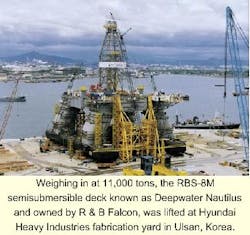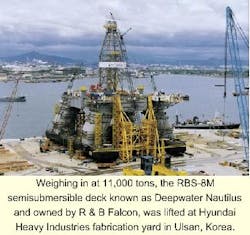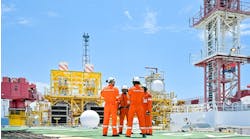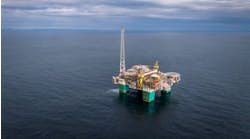The offshore industry has seen two significant projects in 1999 performed with the use of strand jack and tower lift technology:
- Brent Spar Decommissioning project: After lifting more than 8,250 tons on one system to raise the Spar from the water, a second temporary sliding gantry system performed four lift and traverse operations with a load of up to 2,500 tons.
- Record onshore lift: Possibly a new world record for an onshore lift was the 12,000-ton deck lifting of the RBS 8-M semisubmersible at Hyundai Heavy Industries' Ulsan Yard. The lift aided Hyundai in introducing a new technique of fabricating semisubmersibles completely out of the drydock.
The strand jack and tower lift technology was developed and operated by PSC Heavy Lift Ltd. Strand jack technology is still considered specialist, but the lift process is becoming part of the mainstream engineering methodology in the fabrication of heavy structures. The equipment can either facilitate traditional construction methods or enable entirely new construction methods.
Strand operation
The benefits of strand jacks can be determined by understanding how the jacking system works and how the separate components, jacks, strand, power packs, control mechanisms, and support towers combine to create a jacking system.
The development of heavy lifting by strand jacks has its origins in the use of very high tensile stranded steel cables - "strands" - for developing very large forces in prestressed concrete structures. The high-pressure hydraulic jacks originally developed for tensioning prestressed concrete cables form the basis of the jacks used for heavy lifting.
The PSC strand jack lifts lower or move structures in a series of increments roughly equivalent to the stroke of the hydraulic jack. For the purpose of lifting or moving operations, the jack piston is simply extended and retracted in sequence. The wedge grip mechanisms automatically lock onto the lifting cable and pull it through the jack as the piston extends, and then locks it in its new position as the piston retracts to reset. A similar reverse sequence is used for lowering operations. Secondary hydraulic systems incorporated in the gripping mechanisms are used to release them and allow passage of the cable down through the anchor as the piston retracts, and no automatic lifting as the piston extends to reset.
Functionality
The jacks, which come in a range between 15 tons and 600 tons capacity, may be used individually, in pairs close together, or in groups to give any combination of lifting capacity required. They all have the following basic characteristics:
- Mechanically fail-safe gripping mechanism.
- Operating speeds up to 60 meters per hour.
- Final positioning to millimeter accuracy.
- Automatically synchronized operating speeds, regardless of load.
- Completely self contained.
- Load held mechanically, not hydraulically, if stopped with jack piston at part stroke.
- Full access to gripping mechanisms at all times.
- No requirement for re-lubrication of gripping mechanisms after initial installations.
- May be used in the vertical through to horizontal and even inverted position with equal efficiency.
The actual lifting capacity of any jack is directly related to the number of strands which are used with that particular jack, and is calculated based on a load factor of 2.5 on the breaking load of each strand. Thus typically, for the L300 jack, 19 strands having an individual breaking capacity of 38 tons and a total breaking capacity of 722 tons, are used to provide a safe working load of 290 tons.
Strand makeup
The strand now used is of 0.7 in. (18 mm) diameter, with 7 wires in 6/1 construction, which is die-formed after standing to further compact the wires. The 6/1 construction of strand is simply anchored and the problems associated with terminations of multi-layer ropes are easily avoided.
Although grouped in a "cable", all strands are anchored individually, which ensures the development of the full cable strength and, at the same time, ensures a high degree of redundancy in the cable. It is also significant that the strand is a very economical tension medium - possibly one of the most economical in existence.
Jack operation
To operate jacks continuously at reasonable speed requires hydraulic pumps. Larger jacks, larger numbers of jacks, higher speeds, or all of these require, very large hydraulic pumps.
The actual control and monitoring of the jack or system of jacks requires sophisticated arrangements of valves - manual, solenoid, or pilot operated - and gauges or transducers or electrical potentiometers.
The power packs used with strand jacks range from the smallest electric units, which are hand portable to units of 5-6 tons in weight, fitted with 180-hp diesel engines capable of operating a system of jacks lifting over 1,000 tons at a speed of 50 ft/hour.
Without going through all the features of hydraulic power packs, the minimum functional requirements of properly de sign ed heavy-lift power packs, and certainly those at PSC are as follows:
- Power packs should be designed so that all jacks in a system will operate at the same speed - even if they are not all carrying the same load. This keeps the lift in the right attitude and keeps the individual jack loads distributed as planned.
- It must be possible to pre-set a pumping pressure, and hence lifting force, to prevent inadvertent overload on each jack in a system.
- It must be possible also to adjust the pre-set intentionally.
- It must be possible to open or close the flow to any or all of the jacks in a system for lift adjustment.
- The actual pumping pressure, hence load, at each jack must be visible to the operator.
- The operator's functional controls must be simple and unambiguous.
Control mechanisms
As computer technology has evolved, so have the control systems for strand jacking. At this stage, PSC has designed windows-based programs that allow fully remote control, and even fully automatic control.
The display interface of the program allows instant access to load and jack stroke data, manual adjustment of all jacks or individual jacks, and real time plotting of time against pressure. Further introduction of laser technology allows automatic shutdown of the system, should it move outside pre-set tolerances.
The final element of the jacking system that can be provided, if it is relevant to the project, is PSC's proprietary tower lift system. It is an extremely heavy duty structural support and is specifically designed in modular form for ease of assembly, erection, and world-wide transportation.
In its basic form, it is assembled from only two member legs and bracings. Bracings are connected to the legs by means of a single pin at each end. Two sets of connection points are provided on all legs so that the same members may be assembled in either three-leg triangular or four-leg square format towers.
The design philosophy is to provide a support structure which requires minimal external guying for reduced site disruption. Because of its versatility as a temporary support structure, the tower lift can be used in varying ways to produce the most economical lifting arrangement. Examples of typical formats are paired towers with crosshead beams, four-square towers with crosshead beams, towers with cantilevered beams, independent luffed towers, and portalized luffed towers.
What to consider
On any project, the greatest potential for savings is in the conceptual design and planning stages. By the time the project has moved forward to procurement and completion, the scope for savings is greatly diminished. The consideration of strand jacking early in a process allows for full exploitation of costs savings. Structures can be fabricated in heavier assemblies before final positioning. Jacks can be used in areas with limited access, or used to reduce the size of cranes required. Jacks can be on site for less time and mobilized/de-mobilized more quickly. Strand jacks are a means of making construction more efficient.
Hyundai semi lift
In a contract awarded by Hyundai Heavy Industries to PSC Heavy Lift, the deck was lifted with the aid of 24 No. PSC L600 Strand Jacks over a total vertical distance of 38 meters. This allowed the two lower hull sections to be skidded underneath the deck, using an active loadout system supplied by PSC, to complete the semisub mersible structure.
The lifting method employed six temporary lifting towers, two each at the forward and aft sides of the deck, with each tower supporting a pair of PSC L600 strand jacks. A further two cylindrical shaped towers, placed in the center of the deck in line with the opposing pairs of forward and aft towers, each supported eight PSC L600 strand jacks. The use of PSC's computer control system allowed synchronization of the jacking system, and precise control during the mating of the deck to the lower hull sections to within millimeters.
In early November, PSC will perform another loadout of the complete 25,500-ton semisubmersible over a distance of 120 meters, using eight of the L600 strand jacks.
Shell Brent Spar
PSC Heavy Lift Ltd was awarded two contracts by Wood-GMC, the Anglo-Norwegian venture that decommissioned the Brent Spar installation. The first, placed by Wood-GMC's subcontractor Heerema Marine Contractors, was to provide a lifting system, and the second, placed directly by Wood-GMC, was for provision of a traveling gantry system, both of which were to help dismantling operations carried out in a Norwegian Fjord.
As part of Shell's commitment to finding the best practical environmental option for disposing of the spar structure, Wood-GMC was awarded the contract in 1998 to decommission the spar, recycle most of the material, and use some of it to build a quay extension at Mekjarvik in Norway.
The first order, placed by Wood-GMC's subcontractor Heerema Marine Contractors, was to provide engineered strand jack lifting services for raising the spar from the water so that it could be cut into sections, known as cans. Eighteen 560-ton capacity PSC L600 jacks, linked to a computerized control system, were divided equally along two beams which cantilevered from the end of one of the world's largest barges, the H851, owned by Heerema. The L600 jack cables were then connected to a 600 ton cradle, which was lowered into the water to a depth of over 100 meters to allow the spar to be moved over the cradle. The jacking system then lifted each section of the spar to its cut height. The total weight lifted was approximately 7,500 tons.
After an initial lift to allow the cutting of a 17-meter diameter transition piece, each one of the three remaining lifting operations raised the 29-meter-diameter spar by 23.25 meters above the water so that a can, weighing up to 2,250 tons, could be cut. The traveling gantry system, supplied by PSC under a second order, directly for Wood-GMC, then lifted each can in turn, and with the aid of the existing barge skid track system, placed all four cans along the main barge structure. The fifth piece remained on the cradle for the H851's journey to the ferry terminal site.




